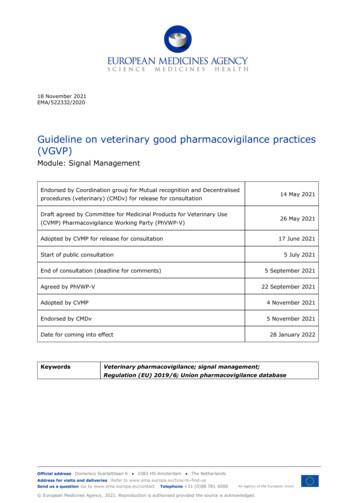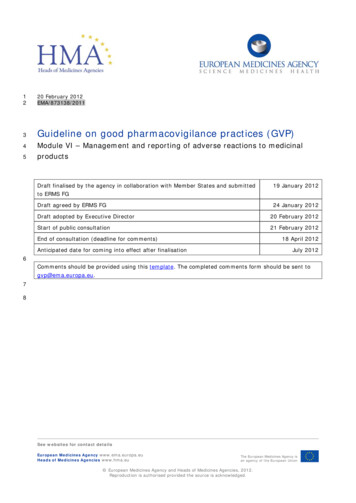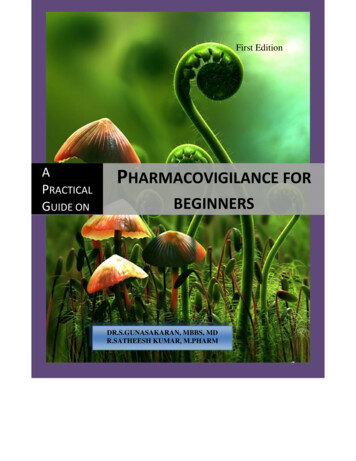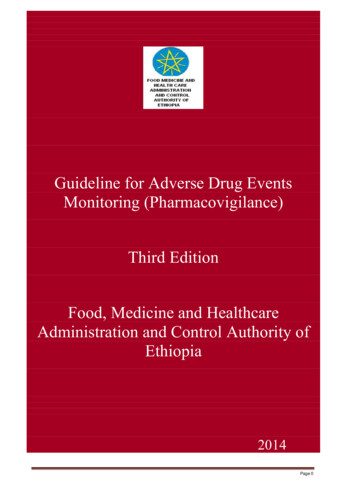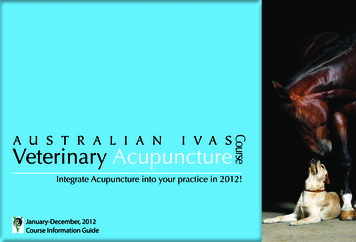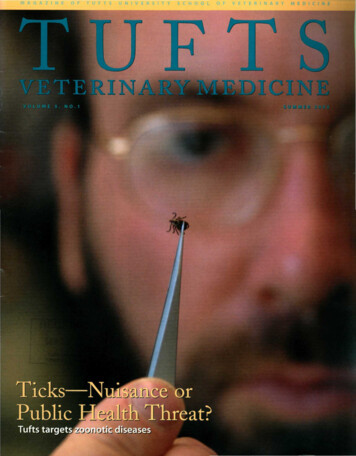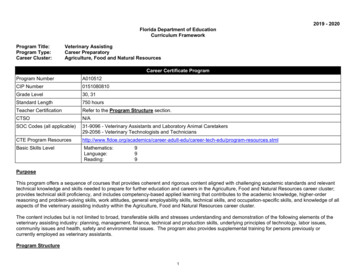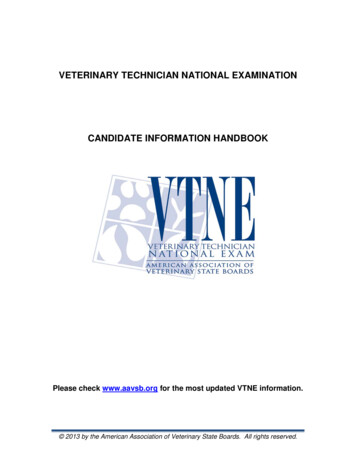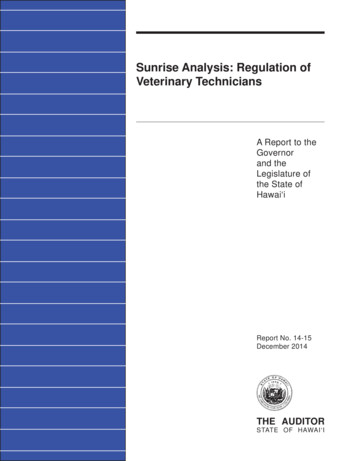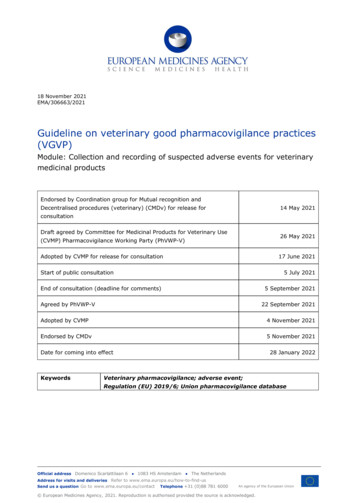
Transcription
18 November 2021EMA/306663/2021Guideline on veterinary good pharmacovigilance practices(VGVP)Module: Collection and recording of suspected adverse events for veterinarymedicinal productsEndorsed by Coordination group for Mutual recognition andDecentralised procedures (veterinary) (CMDv) for release for14 May 2021consultationDraft agreed by Committee for Medicinal Products for Veterinary Use26 May 2021(CVMP) Pharmacovigilance Working Party (PhVWP-V)Adopted by CVMP for release for consultation17 June 2021Start of public consultation5 July 2021End of consultation (deadline for comments)5 September 2021Agreed by PhVWP-V22 September 2021Adopted by CVMP4 November 2021Endorsed by CMDv5 November 2021Date for coming into effectKeywords28 January 2022Veterinary pharmacovigilance; adverse event;Regulation (EU) 2019/6; Union pharmacovigilance databaseOfficial address Domenico Scarlattilaan 6 1083 HS Amsterdam The NetherlandsAddress for visits and deliveries Refer to www.ema.europa.eu/how-to-find-usSend us a question Go to www.ema.europa.eu/contactTelephone 31 (0)88 781 6000An agency of the European Union European Medicines Agency, 2021. Reproduction is authorised provided the source is acknowledged.
Table of contents1. Introduction . 32. Structures and processes . 32.1. Collection of suspected adverse events . 32.1.1. Unsolicited reports . 42.1.2. Solicited reports . 62.2. Validation of suspected adverse event reports . 62.3. Suspected adverse events following the use of medicinal products for human use . 112.4. Information related to pre-mixes and medicated feeding stuffs .2.5. Investigation of fatal outcome .2.6. Suspected adverse event(s) in humans .2.7. Reports on investigations of the validity of a withdrawal period .2.8. Suspected adverse event reports after suspension, revocation or withdrawal of amarketing authorisation for safety or commercial reasons .2.9. Suspected transmission of an infectious agent via a veterinary medicinal product .2.10. Suspected adverse events involving suspected or confirmed quality defects .2.11. Handling of duplicate reports.11111112121213132.12. Electronic transmission of suspected adverse event reports . 142.13. Follow-up of suspected adverse event reports. 142.14. Data privacy management . 152.15. Suspected adverse event reports data quality management . 152.15.1. Data quality management of specific suspected adverse event reports . 162.16. Off-label use . 172.17. Special situations . 182.18. Suspected adverse events involving an untreated animal exposed to a veterinarymedicinal product via a treated animal . 192.19. Suspected adverse event reports related to homeopathic veterinary medicinal products. 19Definitions . 19Appendix . 20Guideline on veterinary good pharmacovigilance practices (VGVP) Collection and recording of suspected adverse events for veterinary medicinal productsEMA/306663/2021Page 2/20
1. IntroductionThis module of the guideline on veterinary good pharmacovigilance practices (VGVP) brings togethergeneral guidance for marketing authorisation holders, national competent authorities and the Agencyon the requirements, roles, activities and procedures related to collection and recording of suspectedadverse events for veterinary medicinal products occurring within the EU/EEA or in third countries.Suspected adverse event reporting is the primary information source for post-authorisation safetymonitoring for medicinal products, including veterinary medicinal products, and provides most of thedata for the evaluation of the benefit-risk profile of a medicinal product.Suspected adverse event reports are recorded in the Union pharmacovigilance database (EVV, fromEudraVigilance Veterinary), which is interconnected to the Union product database (UPD).This module provides details on the principles and procedures for best practice on collection, reportingand recording of suspected adverse events for veterinary medicinal products for marketingauthorisation holders, national competent authorities, the Agency and the Commission forsafeguarding animal and public health and the environment.This module is applicable to authorised veterinary medicinal products in the EU/EEA irrespective of theauthorisation procedure (centralised or national authorisation, including mutual recognition,decentralised and subsequent recognition procedures) and registered homeopathic veterinarymedicinal products. For the scope of this module, the responsibilities of registration holders ofhomeopathic veterinary medicinal products are the same as those for marketing authorisation holders.For veterinary medicinal products not authorised in the EU/EEA whereas being used in accordance withthe provisions of Articles 110, 112-114 of Regulation (EU) 2019/6, it is advised for the nationalcompetent authorities to collect any suspected adverse event reports having occurred in the EU/EEAand to record them in the Union pharmacovigilance database. Marketing authorisation holders in theEU/EEA receiving suspected adverse event reports on veterinary medicinal products used in line withthese provisions, are advised to send these reports directly to the relevant national competentauthority in the EU/EEA.This module should be read in conjunction with Regulation (EU) 2019/6 of the European Parliamentand of the Council of 11 December 2018 on veterinary medicinal products and repealingDirective 2001/82/EC (the Regulation) and Commission Implementing Regulation (EU) 2021/1281 of2 August 2021 laying down rules for the application of Regulation (EU) 2019/6 of the EuropeanParliament and of the Council as regards good pharmacovigilance practice and on the format, contentand summary of the pharmacovigilance system master file for veterinary medicinal products1.2. Structures and processes2.1. Collection of suspected adverse eventsNational competent authorities, the Agency and marketing authorisation holders should encourage thereporting of suspected adverse events associated with authorised veterinary medicinal productsoriginating from unsolicited or solicited sources. National competent authorities and marketingauthorisation holders should take appropriate measures to collect and collate all such N/TXT/?uri CELEX%3A32021R1281&qid 1627975964936Guideline on veterinary good pharmacovigilance practices (VGVP) Collection and recording of suspected adverse events for veterinary medicinal productsEMA/306663/2021Page 3/20
National competent authorities, the Commission, the Agency and marketing authorisation holders shallcollaborate in setting up and maintaining a Union pharmacovigilance database to carry outpharmacovigilance tasks with respect to the safety and efficacy of authorised veterinary medicinalproducts in order to ensure continuous assessment of the benefit-risk balance (see Article 73(1) ofRegulation (EU) 2019/6).The following suspected adverse events shall be collected and recorded in the Union pharmacovigilancedatabase by the marketing authorisation holders and the national competent authorities (seeArticle 73(2) of Regulation (EU) 2019/6): any unfavourable and unintended reaction in any animal to a veterinary medicinal product; any observation of a lack of efficacy of a veterinary medicinal product following its administrationto an animal, whether or not in accordance with the summary of product characteristics; any environmental incidents observed following the administration of a veterinary medicinalproduct to an animal; any noxious reaction in humans exposed to a veterinary medicinal product; any finding of a pharmacologically active substance or marker residue in a product of animal originexceeding the maximum levels of residues established in accordance withRegulation (EC) No 470/2009 after the set withdrawal period has been respected; any suspected transmission of an infectious agent via a veterinary medicinal product; any unfavourable and unintended reaction in an animal to a medicinal product for human use.In accordance with the quality management system requirements as stated in Chapter 2 of theCommission Implementing Regulation (EU) 2021/1281 and in the VGVP module on controls andpharmacovigilance inspections, marketing authorisation holders should have procedures in place toensure that the collection of suspected adverse events and their recording in the Unionpharmacovigilance database complies with the legislative requirements and the further details providedin this module, as appropriate. Where a marketing authorisation holder has set up contractualarrangements with a third party (person or an organisation), explicit procedures and detailedagreements should exist between the marketing authorisation holder and the person/organisation toensure that the collection of suspected adverse events and their recording in the Unionpharmacovigilance database comply with the legislative requirements and the further details providedin this module, as appropriate.2.1.1. Unsolicited reportsSpontaneous reportsA spontaneous report is an unsolicited communication by a veterinarian or other healthcareprofessional or a member of the general public to a national competent authority, marketingauthorisation holder or other organisation (e.g. regional pharmacovigilance centre, poison controlcentre) that describes one or more suspected adverse events observed in an animal or a number ofanimals or a human or in the environment following exposure to one or more medicinal products. Itdoes not derive from a study or any organised data collection systems. All spontaneous suspectedadverse event reports shall be recorded in the Union pharmacovigilance database without delay and nolater than within 30 days from their date of receipt in line with the time frame stated in Article 76(1)and (2) of Regulation (EU) 2019/6 (see section 2.2 for validation of suspected adverse event reports).Guideline on veterinary good pharmacovigilance practices (VGVP) Collection and recording of suspected adverse events for veterinary medicinal productsEMA/306663/2021Page 4/20
2.1.1.2. Literature reportsScientific literature is an additional useful source of information for monitoring the benefit-risk balanceof veterinary medicinal products, particularly in relation to the detection of new safety signals,emerging safety issues and potentially important efficacy or environmental issues.Marketing authorisation holders are expected to review scientific literature in line with their internalprocedures using relevant databases for information related to their authorised veterinary medicinalproducts.Marketing authorisation holders should conduct such a review at least once a year, where necessarymore frequently based on a risk-based approach, and ensure that any identified suspected adverseevent reports are recorded in the Union pharmacovigilance database prior to the “Due date” set for thesignal management procedure (i.e. the agreed annual date for the marketing authorisation holders tosubmit the annual statements for each of their authorised veterinary medicinal products) (see VGVPmodule on signal management).Marketing authorisation holders shall record in the Union pharmacovigilance database the suspectedadverse event reports identified in scientific literature without delay and no later than within 30 daysfrom their date of receipt in line with the time frame stated in Article 76(2) of Regulation (EU) 2019/6,whenever their authorised veterinary medicinal product(s) has/have been identified in the literaturerecords.The literature review should be performed in a thorough and well-structured manner with regard toadequacy of search criteria used (e.g. key words, search terms) and databases searched, to ensure thecompleteness of search results. Marketing authorisation holders should ensure that procedures are inplace to monitor publications in relevant peer-reviewed scientific journals. In case the marketingauthorisation holders become aware of publications in non-peer-reviewed local journals, the suspectedadverse events identified in these publications should be reported as well. Marketing authorisationholders should have procedures in place on how the publications in non-peer-reviewed local journalsare brought to the attention of their safety department as appropriate.Contractual arrangements may be set up with a third party (person or organisation) to performliterature searches and record any identified suspected adverse events in the Union pharmacovigilancedatabase. If a third party is performing these tasks, procedures and detailed agreements shall be inplace and documented according to Article 21(2) of the Commission ImplementingRegulation (EU) 2021/1281 following the guidance provided in the VGVP module on controls andpharmacovigilance inspections to ensure that the marketing authorisation holder is promptly madeaware of any suspected adverse events described in the scientific literature. The deadline for recordingin the Union pharmacovigilance database of suspected adverse events identified by a third party in theliterature should be based upon when the third party becomes aware of a publication containing theminimum information for a valid suspected adverse event report.2.1.1.3. Reports from other non-medical sources, internet or digital mediaMarketing authorisation holders should regularly screen the internet or digital media2 under theirmanagement or responsibility, for any reports of suspected adverse events. The frequency of screeningshould allow for suspected adverse event reports to be recorded in the Union pharmacovigilancedatabase without delay and no later than within 30 days from the date the information was posted onthe internet site/digital media, in line with the time frame stated in Article 76(2) ofAlthough not exhaustive, the following list should be considered as digital media: web site, web page, blog, vlog, socialnetwork, internet forum, chat room, health portal.2Guideline on veterinary good pharmacovigilance practices (VGVP) Collection and recording of suspected adverse events for veterinary medicinal productsEMA/306663/2021Page 5/20
Regulation (EU) 2019/6. Marketing authorisation holders may consider utilising their websites tofacilitate the collection of suspected adverse event reports. If a marketing authorisation holderbecomes aware of a report of a suspected adverse event described in any non-company sponsoreddigital media or non-medical source, reasonable efforts, as described in internal procedures of themarketing authorisation holder, should be made to follow-up the case in order to obtain the minimuminformation that constitutes a valid suspected adverse event report. All suspected adverse eventreports originating from any non-company sponsored digital media or non-medical source should berecorded in the Union pharmacovigilance database without delay and no later than within 30 days fromthe date the marketing authorisation holder was made aware of the report, in line with the time framestated in Article 76(2) of Regulation (EU) 2019/6. In relation to cases from the internet or digitalmedia, the ability to identify a reporter for a valid suspected adverse event report may depend onverifying the existence of a real person based on the information available e.g. an email address. If thecountry of the primary source is missing, the country where the information was received should beused as the primary source country.2.1.2. Solicited reportsAll suspected adverse event reports originating from clinical studies for authorised veterinary medicinalproducts (e.g. clinical studies conducted to investigate a new indication, a new species, new methodsof administration or new combinations) and post-marketing surveillance studies related to veterinarymedicinal products (refer to VGVP Glossary for the definition of post-marketing surveillance studies)shall be recorded in the Union pharmacovigilance database in line with the requirements stated inArticle 76(1) and (2) of Regulation (EU) 2019/6. These cases should be recorded in the Unionpharmacovigilance database without delay and no later than within 30 days from the date of theclosure of the final study report.2.2. Validation of suspected adverse event reportsSuspected adverse event reports from veterinarians or other healthcare professionals or the generalpublic may be submitted in writing, by telephone, or electronically (e.g. via online reporting forms) tonational competent authorities or marketing authorisation holders, however they cannot be directlyrecorded by those veterinarians or other healthcare professionals or the general public in the Unionpharmacovigilance database.Only valid suspected adverse event reports qualify for recording in the Union pharmacovigilancedatabase. A suspected adverse event report should be considered valid when it contains at least theminimum information outlined below.Additional criteria apply to enable recording suspected adverse event reports in the Unionpharmacovigilance database, and they may be marked as mandatory or non-mandatory fields (forguidance see EVV - Best practice guide and EU VICH adverse event report implementation guide inAppendix).It is essential for marketing authorisation holders and national competent authorities to provide asmuch detail as possible, including all relevant clinical information, in order to facilitate assessment.Suspected adverse event reports identified from published scientific literature should be screened,reviewed and assessed to ensure the minimum criteria for reporting of suspected adverse events aresatisfied.The reference point for deadlines for recording suspected adverse event reports in the Unionpharmacovigilance database (day zero) is the date of receipt of the minimum information for a validGuideline on veterinary good pharmacovigilance practices (VGVP) Collection and recording of suspected adverse events for veterinary medicinal productsEMA/306663/2021Page 6/20
report (“Original Receive Date”) by a national competent authority or a marketing authorisation holder,including a third party (person or organisation) with which the marketing authorisation holder has setup a contractual arrangement, irrespective of whether the information is received during a weekend orpublic holiday. The time frame for recording suspected adverse events in the Union pharmacovigilancedatabase is based on calendar days.a) Minimum information for a suspected adverse event report to be considered valid:1. An identifiable primary reporter or source (including the country code):The primary reporter is the person who first reports the suspected adverse event and corresponds tothe primary source of information. In case of follow-up information being reported by a persondiffering from the primary reporter, this should be recorded in the Union pharmacovigilance databaseas “other reporter”.Whenever possible, the contact details for the primary reporter should be recorded by the notifiedorganisation (i.e. marketing authorisation holder or national competent authority) to facilitate followup activities. However, if the primary reporter does not wish to provide contact information, thesuspected adverse event report should still be considered valid as long as the notified organisation isable to confirm the case directly with the reporter. The identifiability of the reporter refers to thepossibility of verification of the existence of a real person based on the information available.For suspected adverse events identified from the internet or digital media without a known reportingsource (see section 2.1.1.3.), reasonable efforts should be made to contact the “notifier” or “author” toobtain a contactable email address (i.e. an email address under a valid format and not just a digitalmedia nickname) in order for the suspected adverse event report to be considered valid. The “notifier”or “author” should be encouraged to complete a suspected adverse event reporting form (e.g.marketing authorisation holder or national competent authority form), to ensure the suspected adverseevent is captured and recorded in the Union pharmacovigilance database.In case of more than one identifiable reporter, the reporter who provides the most pertinentinformation related to the suspected adverse event report should be considered as the primaryreporter and any other reporter should be recorded as “other reporter”.For suspected adverse events identified in scientific literature, the first publication author (or thecorresponding author, if designated) should be considered as the source of information and recordedas primary reporter. Details about the co-authors are not required to be documented among thesources of information. The literature references should be clearly identified and recorded in the Unionpharmacovigilance database. Additional relevant identifiers including at least a standardised digitalobject identifier3 if available, should also be recorded. Should further information be required, theauthors of the publication should be contacted.2. Details of identifiable affected animal(s) or human(s) or environment:Species (including “human” when applicable) and number of animals or individuals affected is theminimum information required for a valid suspected adverse event report. The number (known orestimated) of animals or individuals affected should also include indirectly exposed animals orindividuals, e.g. offspring from animals or individuals treated during pregnancy, suckling animals orinfants, animals or individuals affected from infectious spread or through commingling (e.g. lickingtopical medicinal products).DOI digital object identifier, standardised - (ISO 26324, Information and Documentation - Digital Object IdentifierSystem (2012), - Mechanism for, and emphasis on, enabling re-use of other existing identifier schemes, e.g., ISBN; see“DOI System and Standard Identifier Schemes”.)3Guideline on veterinary good pharmacovigilance practices (VGVP) Collection and recording of suspected adverse events for veterinary medicinal productsEMA/306663/2021Page 7/20
If a suspected adverse event in animals involves more than one species, a separate suspected adverseevent report should be recorded in the Union pharmacovigilance database for each species involved.These reports should then be linked using the appropriate field.If a suspected adverse event involves more than one human, a separate suspected adverse eventreport should be recorded in the Union pharmacovigilance database for each human involved. Thesereports should then be linked using the appropriate field.In case a suspected adverse event identified in scientific literature involves more than one human, onesuspected adverse event report should be recorded in the Union pharmacovigilance database for eachsingle identifiable human and these reports should be linked using the appropriate field. In casemarketing authorisation holders become aware of scientific literature on suspected adverse event(s)concerning a group of humans who cannot be identified individually for recording separate suspectedadverse event reports, the marketing authorisation holders should send a notification summarising thefindings to the signal module of the Union pharmacovigilance database. In case national competentauthorities become aware of scientific literature on suspected adverse event(s) concerning a group ofhumans who cannot be identified individually for recording separate suspected adverse event reports,national competent authorities are advised to notify the concerned marketing authorisation holder(s)with a view to them investigating these findings and sending a notification summarising the findings tothe signal module of the Union pharmacovigilance database.For environmental incident(s) (refer to VGVP Glossary for the definition) the following informationshould be recorded in addition to the animal species and number of animals affected: the type ofinformation in the suspected adverse event report should be “Other” and the relevant VeDDRA term(s)should be selected. Any specific information regarding environmental incidents should be recorded inthe case narrative.3. One or more medicinal product(s)/active substance(s) (veterinary or human):Details of all medicinal product(s) to which the animal(s), human(s) or the environment were exposedprior to the occurrence of adverse events, should be recorded together with their Lot number(s), ifavailable.Where the name of the medicinal product(s) is(are) not included in the initial report, marketingauthorisation holders and national competent authorities shall make reasonable efforts to obtain thename or at least part of the trade name of all medicinal product(s) concerned according toArticle 12(3) of the Commission Implementing Regulation (EU) 2021/1281. Exceptionally, where (a)specific medicinal product(s) cannot be identified, the name(s) of the active substance(s) shall berecorded.4. Suspected adverse event(s) details:Clinical signs (including abnormal laboratory findings), diagnosis, or symptoms (for adverse event(s) inhumans).Any of the above should be recorded and the relevant VeDDRA terms should be selected. The number(estimated or known) of animals affected by each adverse event should be recorded against therelevant VeDDRA term.The date of onset of the suspected adverse event should also be recorded if available.Reasonable efforts should be made in order to clarify details of the event(s).All suspected adverse event reports should be recorded in the Union pharmacovigilance database inline with the time frame stated in Article 76(1) and (2) of Regulation (EU) 2019/6, irrespective of theirGuideline on veterinary good pharmacovigilance practices (VGVP) Collection and recording of suspected adverse events for veterinary medicinal productsEMA/306663/2021Page 8/20
seriousness classification. However, the VICH (Veterinary International Conference on Harmonization)guideline on pharmacovigilance VICH GL244 requires the classification of a suspected adverse report as“serious” or “non serious” to be recorded in the Union pharmacovigilance database. The definition of aserious adverse event is outlined in VICH GL244. All suspected adverse event reports may beconsidered for signal detection (see prioritisation criteria as outlined in the VGVP module on signalmanagement).b) Case narrativeThe case narrative is very important and should contain all known relevant clinical and relatedinformation as provided by the primary reporter (i.e. original verbatim text reported by the primaryreporter). This information should also be recorded using the VeDDRA terminology, including animal orhuman or environment details, exposure or treatment details. The course of suspected adverseevent(s) and a description of the suspected adverse event(s) including the outcome, diagnosis, andany other information regarding the suspected and concomitant medicinal products (e.g. laboratorytest results, necropsy findings) should also be recorded. Any other relevant information available tofacilitate assessment of the case should be provided, such as disposition to allergy, changes in feedinghabits, or effects on production parameters (e.g. body weight gain, Feed Conversion Ratio (FCR), bodygrowth). The case narrative should serve as a complete and comprehensive case report, presented in alogical sequence, ideally in chronological order. The use of abbreviations and acronyms should beavoided.Where applicable, the information in the case narrative should also be provided in structured format inthe applicable fields (i.e. coded) in the Union pharmacovigilance database to facilitate data analysis.The following elements, if available, are important for the evaluation of the report:1.Description of suspected adverse event(s) including site and severity (intensity of the adverseevent) and observed clinical signs.2.Start date or onset of suspected adverse event.3.Stop date or duration of suspected adverse event.4.Specific measures taken to treat the observed suspected adverse event.5.Number of animals showing clinical signs.6.Number of animals dead.7.De-challenge information (e.g. any obvious effect of removal of treatment).8.Re-challenge information (e.g. any obvious effect of re-introduction of treatment).9.If available, the following information should be provided:9.1.Number of treated animals alive w
Guideline on veterinary good pharmacovigilance practices (VGVP) - Collection and recording of suspected adverse events for veterinary medicinal products

